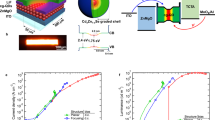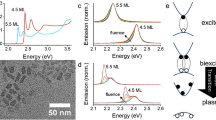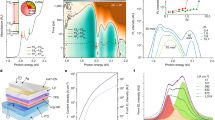Abstract
Colloidal semiconductor quantum dots are attractive materials for the realization of solution-processable lasers. However, their applications as optical-gain media are complicated by a non-unity degeneracy of band-edge states, because of which multiexcitons are required to achieve the lasing regime. This increases the lasing thresholds and leads to very short optical gain lifetimes limited by nonradiative Auger recombination. Here, we show that these problems can be at least partially resolved by employing not neutral but negatively charged quantum dots. By applying photodoping to specially engineered quantum dots with impeded Auger decay, we demonstrate a considerable reduction of the optical gain threshold due to suppression of ground-state absorption by pre-existing carriers. Moreover, by injecting approximately one electron per dot on average, we achieve a more than twofold reduction in the amplified spontaneous emission threshold, bringing it to the sub-single-exciton level. These measurements indicate the feasibility of ‘zero-threshold’ gain achievable by completely blocking the band-edge state with two electrons.
This is a preview of subscription content, access via your institution
Access options
Access Nature and 54 other Nature Portfolio journals
Get Nature+, our best-value online-access subscription
$29.99 / 30 days
cancel any time
Subscribe to this journal
Receive 12 print issues and online access
$259.00 per year
only $21.58 per issue
Buy this article
- Purchase on Springer Link
- Instant access to full article PDF
Prices may be subject to local taxes which are calculated during checkout





Similar content being viewed by others
References
Klimov, V. I. et al. Optical gain and stimulated emission in nanocrystal quantum dots. Science 290, 314–317 (2000).
Nurmikko, A. What future for quantum dot-based light emitters? Nat. Nanotech. 10, 1001–1004 (2015).
Pietryga, J. M. et al. Spectroscopic and device aspects of nanocrystal quantum dots. Chem. Rev. 116, 10513–10622 (2016).
Asada, M., Miyamoto, Y. & Suematsu, Y. Gain and the threshold of 3-dimensional quantum-box lasers. IEEE J. Quantum Electron. 22, 1915–1921 (1986).
Eisler, H.-J. et al. Color-selective semiconductor nanocrystal laser. Appl. Phys. Lett. 80, 4614–4616 (2002).
Malko, A. V. et al. From amplified spontaneous emission to microring lasing using nanocrystal quantum dot solids. Appl. Phys. Lett. 81, 1303–1305 (2002).
Schaller, R., Petruska, M. & Klimov, V. Tunable near-infrared optical gain and amplified spontaneous emission using PbSe nanocrystals. J. Phys. Chem. B 107, 13765–13768 (2003).
Petruska, M. A., Malko, A. V., Voyles, P. M. & Klimov, V. I. High-performance, quantum dot nanocomposites for nonlinear optical and optical gain applications. Adv. Mater. 15, 610–613 (2003).
Sundar, V. C., Eisler, H. J. & Bawendi, M. G. Room-temperature, tunable gain media from novel II–VI nanocrystal–titania composite matrices. Adv. Mater. 14, 739–743 (2002).
Fan, F. et al. Continuous-wave lasing in colloidal quantum dot solids enabled by facet-selective epitaxy. Nature 544, 75–79 (2017).
Klimov, V. I. et al. Quantization of multiparticle Auger rates in semiconductor quantum dots. Science 287, 1011–1013 (2000).
Saba, M. et al. Exciton–exciton interaction and optical gain in colloidal CdSe/CdS dot/rod nanocrystals. Adv. Mater. 21, 4942–4946 (2009).
Garcia-Santamaria, F. et al. Suppressed Auger recombination in ‘giant’ nanocrystals boosts optical gain performance. Nano Lett. 9, 3482–3488 (2009).
Liao, Y. et al. Low threshold, amplified spontaneous emission from core-seeded semiconductor nanotetrapods incorporated into a sol–gel matrix. Adv. Mater. 24, OP159–OP164 (2012).
She, C. et al. Low-threshold stimulated emission using colloidal quantum wells. Nano Lett. 14, 2772–2777 (2014).
Grim, J. Q. et al. Continuous-wave biexciton lasing at room temperature using solution-processed quantum wells. Nat. Nanotech. 9, 891–895 (2014).
Yakunin, S. et al. Low-threshold amplified spontaneous emission and lasing from colloidal nanocrystals of caesium lead halide perovskites. Nat. Commun. 6, 8056 (2015).
Zhu, H. et al. Lead halide perovskite nanowire lasers with low lasing thresholds and high quality factors. Nat. Mater. 14, 636–642 (2015).
Sutherland, B. R. & Sargent, E. H. Perovskite photonic sources. Nat. Photon. 10, 295–302 (2016).
Park, Y.-S. et al. Effect of the core/shell interface on Auger recombination evaluated by single-quantum-dot spectroscopy. Nano Lett. 14, 396–402 (2014).
Osovsky, R. et al. Continuous-wave pumping of multiexciton bands in the photoluminescence spectrum of a single CdTe–CdSe core–shell colloidal quantum dot. Phys. Rev. Lett. 102, 197401 (2009).
Nasilowski, M., Spinicelli, P., Patriarche, G. & Dubertret, B. Gradient CdSe/CdS quantum dots with room temperature biexciton unity quantum yield. Nano Lett. 15, 3953–3958 (2015).
Klimov, V. I. et al. Single-exciton optical gain in semiconductor nanocrystals. Nature 447, 441–446 (2007).
Wang, C., Wehrenberg, B. L., Woo, C. Y. & Guyot-Sionnest, P. Light emission and amplification in charged CdSe quantum dots. J. Phys. Chem. B 108, 9027–9031 (2004).
Haug, A. Influence of doping on threshold current of semiconductor lasers. Electron. Lett. 21, 792–794 (1985).
Copeland, J. Heavily-doped semiconductor lasers. IEEE J. Quantum Electron. 17, 2187–2190 (1981).
Rinehart, J. D. et al. Photochemical electronic doping of colloidal CdSe nanocrystals. J. Am. Chem. Soc. 135, 18782–18785 (2013).
Park, Y.-S. et al. Effect of Auger recombination on lasing in heterostructured quantum dots with engineered core/shell interfaces. Nano Lett. 15, 7319–7328 (2015).
Cragg, G. E. & Efros, A. L. Suppression of Auger processes in confined structures. Nano Lett. 10, 313–317 (2009).
Bae, W. K. et al. Controlled alloying of the core–shell interface in CdSe/CdS quantum dots for suppression of Auger recombination. ACS Nano 7, 3411–3419 (2013).
Robel, I. et al. Universal size-dependent trend in Auger recombination in direct-gap and indirect-gap semiconductor nanocrystals. Phys. Rev. Lett. 102, 177404 (2009).
Qin, W. & Guyot-Sionnest, P. Evidence for the role of holes in blinking: negative and oxidized CdSe/CdS dots. ACS Nano 6, 9125–9132 (2012).
Klimov, V. I. Optical nonlinearities and ultrafast carrier dynamics in semiconductor nanocrystals. J. Phys. Chem. B 104, 6112–6123 (2000).
Klimov, V. I., McBranch, D. W., Leatherdale, C. A. & Bawendi, M. G. Electron and hole relaxation pathways in semiconductor quantum dots. Phys. Rev. B 60, 13740–13749 (1999).
Jha, P. P. & Guyot-Sionnest, P. Trion decay in colloidal quantum dots. ACS Nano 3, 1011–1015 (2009).
Park, Y. -S., Bae, W. K., Pietryga, J. M. & Klimov, V. I. Auger recombination of biexcitons and negative and positive trions in individual quantum dots. ACS Nano 8, 7288–7296 (2014).
Javaux, C. et al. Thermal activation of non-radiative Auger recombination in charged colloidal nanocrystals. Nat. Nanotech. 8, 206–212 (2013).
Shim, M. & Guyot-Sionnest, P. n-type colloidal semiconductor nanocrystals. Nature 407, 981–983 (2000).
Norris, D. J. & Bawendi, M. G. Measurement and assignment of the size-dependent optical spectrum in CdSe quantum dots. Phys. Rev. B 53, 16338–16346 (1996).
Galland, C. et al. Two types of luminescence blinking revealed by spectroelectrochemistry of single quantum dots. Nature 479, 203–207 (2011).
Klimov, V. I. Multicarrier interactions in semiconductor nanocrystals in relation to the phenomena of Auger recombination and carrier multiplication. Annu. Rev. Condens. Matter Phys. 5, 285–316 (2014).
Cohn, A. W. et al. Size dependence of negative trion Auger recombination in photodoped CdSe nanocrystals. Nano Lett. 14, 353–358 (2014).
Klimov, V. I. in Semiconductor and Metal Nanocrystals: Synthesis and Electronic and Optical Properties, 1st edn, 159–214 (CRC, 2004).
Walsh, B. R. et al. Interfacial electronic structure in graded shell nanocrystals dictates their performance for optical gain. J. Phys. Chem. C 120, 19409–19415 (2016).
Walsh, B. R. et al. Controlling the surface of semiconductor nanocrystals for efficient light emission from single excitons to multiexcitons. J. Phys. Chem. C 119, 16383–16389 (2015).
Malak, S. T. et al. Enhancement of optical gain characteristics of quantum dot films by optimization of organic ligands. J. Mater. Chem. C 4, 10069–10081 (2016).
Bae, W. K. et al. Controlling the influence of Auger recombination on the performance of quantum-dot light-emitting diodes. Nat. Commun. 4, 3661 (2013).
Yang, Y. A., Wu, H., Williams, K. R. & Cao, Y. C. Synthesis of CdSe and CdTe nanocrystals without precursor injection. Angew. Chem. Int. Ed. 44, 6712–6715 (2005).
Wang, C., Shim, M. & Guyot-Sionnest, P. Electrochromic nanocrystal quantum dots. Science 291, 2390–2392 (2001).
Koh, W.-K. et al. Heavily doped n-type PbSe and PbS nanocrystals using ground-state charge transfer from cobaltocene. Sci. Rep. 3, 2004 (2013).
Acknowledgements
Work on the synthesis of core/alloy/shell quantum dots and studies of Auger recombination in synthesized materials were supported by the Chemical Sciences, Biosciences and Geosciences Division, Office of Basic Energy Sciences, Office of Science, US Department of Energy. The studies of the effect of charging on quantum dot optical gain properties were supported by the Laboratory Directed Research and Development (LDRD) programme at Los Alamos National Laboratory (LANL). K.W. acknowledges support by a LANL Director's Postdoctoral Fellowship.
Author information
Authors and Affiliations
Contributions
J.L. synthesized the quantum dots and conducted their microstructural characterization. K.W. conducted spectroscopic studies of the effect of charging on quantum dot optical properties. K.W. and Y.-S.P. conducted measurements of amplified spontaneous emission. K.W. and V.I.K. analysed the data and performed modelling of optical-gain performance of charged quantum dots. K.W., Y.-S.P. and V.I.K. performed theoretical modelling of lasing using charged quantum dots. K.W. and V.I.K. wrote the manuscript, with input from the other authors.
Corresponding author
Ethics declarations
Competing interests
The authors declare no competing financial interests.
Supplementary information
Supplementary information
Supplementary information (PDF 3135 kb)
Rights and permissions
About this article
Cite this article
Wu, K., Park, YS., Lim, J. et al. Towards zero-threshold optical gain using charged semiconductor quantum dots. Nature Nanotech 12, 1140–1147 (2017). https://doi.org/10.1038/nnano.2017.189
Received:
Accepted:
Published:
Issue Date:
DOI: https://doi.org/10.1038/nnano.2017.189
This article is cited by
-
Optical gain and lasing from bulk cadmium sulfide nanocrystals through bandgap renormalization
Nature Nanotechnology (2023)
-
Enabling metallic behaviour in two-dimensional superlattice of semiconductor colloidal quantum dots
Nature Communications (2023)
-
Electrically driven amplified spontaneous emission from colloidal quantum dots
Nature (2023)
-
Mid-infrared cascade intraband electroluminescence with HgSe–CdSe core–shell colloidal quantum dots
Nature Photonics (2023)
-
Fabrication of a light-emitting device based on the CdS/ZnS spherical quantum dots
Journal of the European Optical Society-Rapid Publications (2021)



